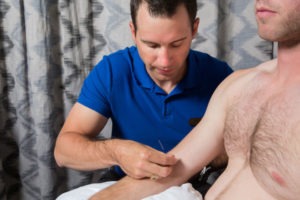Dry Needling Acupuncture
By inserting acupuncture-like needles into dysfunctional tissue at specific points, Dry Needling influences soft tissues through mechanical & biochemical mechanisms – the effects of dry needling can relax “tight” muscles, alter muscle pain and chronic pain perception and reduce the sensation of fatigue/soreness that dysfunctional muscle tone creates. Additionally, dry needling promotes better nerve communication & triggers the release of natural pain-relieving substances within the body.
- Musculoskeletal pain (neck, back, arms, legs, etc.)
- Sprains & strains
- Overuse injuries (i.e. tennis elbow, Achilles’ tendinopathy, etc.)
- Headaches & migraines
- Nerve pain (sciatica, carpal tunnel syndrome, etc.)
- Post-op pain
- Muscle spasms & cramps
- Whiplash-related symptoms
Benefits of Acupuncture and Dry Needling
- Fast Pain Relief: Immediate pain reduction is often experienced after a single session with acupuncture needles, while multiple sessions may be required to optimally reduce pain.
- Improved Range of Motion: By releasing tight & painful muscles, dry needling helps restore full range of motion, enhancing mobility & flexibility.
- Accelerated Recovery: Incorporating dry needling into a physical therapy program promotes faster recovery from injuries or surgical procedures.
- Enhanced Healing Response: Dry needling stimulates a healing response in the body, promoting tissue repair & regeneration.
- Muscle Rehabilitation: Dry needling, combined with an exercise program, aids in muscle retraining, preventing future issues.
- Safe: This is a minimally invasive procedure with a low risk of complications, making it a safe option for pain management.
- Long-lasting Results: With proper treatment & follow-up care, we suggest that acupuncture, can have a lasting impact on pain reduction & improved function.
What is Dry Needling
Dry Needling is a term used for many therapeutic techniques that use a solid, filiform type of acupuncture needles to release a motor point in the muscle. In contrast, a ‘wet needle’ is a needle used to inject a substance into the body (i.e. getting a shot at the doctor’s office). Intramuscular Stimulation (IMS), Functional Dry Needling (FDN) & Biodynamic Dry Needling (BDN) are essentially brand names that depict the practitioner’s specific training background. They are based on scientific, neuro-physiological principles & have a common goal of altering dysfunctional muscle tone & improving muscular pain.
In conventional treatments, Dry Needling can help neuropathic & myofascial pain & dysfunction by:
- producing local twitch responses to change the muscle tone (sometimes called “releasing” the muscle or “trigger point”) to decrease neural sensitivity & improve pain
- altering electrophysiological output & normalizing motor nerve input to the muscle
- decreasing biochemical markers associated with dysfunctional muscle tone
- increasing local inflammatory response and blood flow to promote tissue healing
Available at:
Frequently Asked Questions
Does it hurt? People experience different sensations during an acupuncture session. When needles are inserted some side effects can include muscle cramping, twitching, or a deep ache sensation within the area (like a “Charlie horse” sensation) or along a referral pattern may be felt. Temporary muscle soreness is also expected post-treatment.
How is IMS/FDN/BDN different from Acupuncture? IMS/FDN/BDN treats dysfunctional muscle tone. This often involves the needle going deeper into the muscle belly to elicit a twitch response. Whereas Acupuncture stimulates the body to produce pain-relieving endorphins & is based in theories from the realm of Traditional Chinese Medicine (TCM).
How many treatments are needed? The frequency & duration of treatments vary with each client & condition being treated, ensuring a tailored treatment approach for each individual. For acute treatments, a few sessions may be all that is needed. More complex conditions may need treatment for several weeks. Dry needling is an adjunctive treatment that should be incorporated into a comprehensive treatment plan to have an optimal effect.
What should I do before treatment? It is not recommended to consume alcohol or sedatives prior to treatment.
What should I do after treatment? Regular physical activities should be maintained to decrease the period of post-treatment soreness. Any regular medications should be taken as directed by your physician.
Important Considerations
- Pregnant women or individuals with bleeding disorders or certain other medical conditions should discuss with their therapist if dry needling is the right option for them.
- Electro-needling should be avoided by people with a pacemaker or unstable cardiac conditions.
- Any blood-borne diseases should be disclosed to the practitioner prior to the use of needles.
- Individuals taking anti-coagulants must have a stable INR test.

